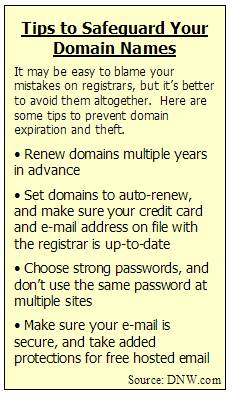<<<
Chronological Index
>>> <<<
Thread Index
>>>
[gnso-pednr-dt] Critical customer mistakes often blamed on domain registrars
- To: "PEDNR" <gnso-pednr-dt@xxxxxxxxx>
- Subject: [gnso-pednr-dt] Critical customer mistakes often blamed on domain registrars
- From: "Diaz, Paul" <pdiaz@xxxxxxxxxxxxxxxxxxxx>
- Date: Tue, 20 Oct 2009 11:11:45 -0400
FYI - Any luck reaching out to Domain Name Wire's Andrew Allemann about
addressing this WG?
Domain Registrars Often Blamed for Customers' Mistakes (Domain Name
Wire, 102009)
http://domainnamewire.com/2009/10/20/domain-registrars-often-blamed-for-
customers-mistakes/
Critical customer mistakes often blamed on domain registrars.
When online backup service CrashPlan.com went down earlier this month,
the company was quick to blame its domain name registrar GoDaddy
<http://godaddy.com> . Code 42 Software, which runs the CrashPlan.com
service, tweeted <http://twitter.com/crashplan> about how GoDaddy
<http://www.kqzyfj.com/click-353176-10378406?sid=dnw> "mistakenly
removed our root nameserver entry", "inappropriately took over our DNS",
and did a DNS "hijack".
What Code 42 Software never tweeted was that it had mistakenly let the
domain name expire. The outage was Code 42's fault, not GoDaddy's.
None of the previous five e-mails GoDaddy sent to Code 42 Software
alerting them to the impending expiration got the company's attention.
The myth that GoDaddy was to blame then spread across the web. One
commenter on an unrelated CNET story wrote
<http://news.cnet.com/8301-13860_3-10375186-56.html> that "GoDaddy
somehow hosed their domain." (Code 42 Software did not respond to a
request for comment for this story.)
Domain registrars frequently get thrown under the bus when one of their
customers makes a mistake. In another case, a registrant of a popular
web site had their non-Go Daddy email account compromised, which allowed
an attacker to steal their domain name by transferring it away from
GoDaddy. The customer publicly blamed GoDaddy, even though the problem
was with the customer's e-mail security.
GoDaddy deals with the brunt of attacks like this, given its massive
size and mass market strategy. But other registrars feel the heat, too.
Earlier this year fingers were pointed at eNom when several high value
domain names were stolen. The real culprit? The customer used a weak
password, allowing the thief to access their account.
Companies with popular web sites have a number of added tools they
should use to protect against many of the most common domain problems.
Moniker and Fabulous offer domain locking tools
<http://domainnamewire.com/2009/01/07/companies-have-fiduciary-responsib
ility-to-lock-down-domain-names/> with added security. GoDaddy offers
Protected Registration
<http://www.godaddy.com/gdshop/protect/landing.asp?ci=9004> . Companies
should also subscribe to DomainTools' Registrant Alert
<http://domainnamewire.com/2009/10/12/every-domain-owner-should-subscrib
e-to-domaintools-registrant-alert/> to find out about potential theft
quickly. The sidebar of this story has other tips for protecting your
domain names.
The difficulty for domain registrars is how quickly misinformation
spreads across the web. It doesn't matter that it was Code 42's fault
that CrashPlan.com went down. It doesn't matter that it wasn't the
registrar's fault that a domain was stolen. Just the accusation,
combined with the viral nature of social media, can damage a registrar's
reputation.

<<<
Chronological Index
>>> <<<
Thread Index
>>>
|
